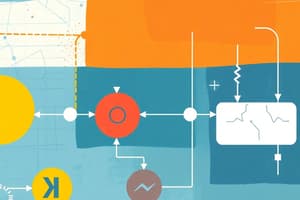Podcast
Questions and Answers
What does the acronym AAH stand for?
What does the acronym AAH stand for?
- Analyzer Alarm High (correct)
- Automatic Adjustment High
- Advanced Analyzer Alarm High
- Analog Analyzer High
Where should the letters identifying an instrument be placed on a remote balloon symbol?
Where should the letters identifying an instrument be placed on a remote balloon symbol?
- Top portion of the balloon (correct)
- Middle portion of the balloon
- Outside the balloon
- Bottom portion of the balloon
What is the primary purpose of a legend on a P & ID?
What is the primary purpose of a legend on a P & ID?
- To define measurement units
- To show what symbols mean (correct)
- To provide detailed operational protocols
- To indicate potential hazards
Which of the following is NOT a correct function of a P & ID?
Which of the following is NOT a correct function of a P & ID?
Which type of gauge is primarily used in areas of heavy vibration?
Which type of gauge is primarily used in areas of heavy vibration?
What is the symbol for a pneumatic signal?
What is the symbol for a pneumatic signal?
Which letter indicates the type of measurement in instrument identification tags?
Which letter indicates the type of measurement in instrument identification tags?
What distinguishes a smart pressure transmitter from a traditional pressure transmitter?
What distinguishes a smart pressure transmitter from a traditional pressure transmitter?
What does the abbreviation 'FCV' stand for?
What does the abbreviation 'FCV' stand for?
Which type of control involves managing processes through pre-programmed logic?
Which type of control involves managing processes through pre-programmed logic?
Which diagram type shows the flow scheme in a sequential block form?
Which diagram type shows the flow scheme in a sequential block form?
What type of pressure instrument is typically filled with mercury and used in furnaces?
What type of pressure instrument is typically filled with mercury and used in furnaces?
What does the symbol for a check valve look like?
What does the symbol for a check valve look like?
What is indicated by false crosshatching on a P & ID?
What is indicated by false crosshatching on a P & ID?
Which controller type is characterized by response to the current error of the system only?
Which controller type is characterized by response to the current error of the system only?
What is expressed by the abbreviation 'TAL'?
What is expressed by the abbreviation 'TAL'?
In a piping and instrumentation diagram, what does 'd/p' refer to?
In a piping and instrumentation diagram, what does 'd/p' refer to?
Which symbol represents a block valve?
Which symbol represents a block valve?
What does the abbreviation 'FIC' stand for?
What does the abbreviation 'FIC' stand for?
What is the correct representation of a motor operated valve?
What is the correct representation of a motor operated valve?
Study Notes
Understanding Process Symbols
- Electronic signal: A dashed line
- Pneumatic signal: A line with angled lines at regular intervals, resembling train tracks
- Digital signal: A dash, a circle, and another dash
- Current to pneumatic transducer: A dashed line connecting to a solid line with angled lines at regular intervals, resembling train tracks
- Check valve: A vertical line with a diagonal arrow, followed by another vertical line.
- Orifice plate: Three vertical lines with a smaller vertical line in the middle.
- Block valve: A bow tie with a “T” on top.
- Control valve: A bow tie with an umbrella on top.
- Motor operated valve: A bow tie with a rectangle containing the letter “M” in the center.
- Pump (show suction & discharge): A suction line going through the middle of the pump and a discharge line at the top.
- Exchanger (tube side): A line going through a tube with zigzag lines.
- Exchanger (shell side): A line pointing towards and out of the tube but not passing through it.
Instrumentation Symbols
- FIC: Flow indicator controller
- TE: Temperature element
- TAL: Temperature alarm low
- PI: Pressure indicator
- LG: Level gauge
- d/p: Differential pressure
- FCV: Flow control valve
- LALL: Level alarm low low
Process Flow Diagrams
- A block flow diagram shows the flow scheme in a sequential block form.
- A process flow diagram (P&ID) pictorially indicates the general flow of the process using symbols and major process equipment, but doesn’t show minor details like instrumentation control loops.
- A pipe and instrumentation diagram shows the interconnection of process equipment and the instrumentation used to control the process.
- Instrument identification uses letters and numbers to uniquely describe instruments on a unit, for example: LIC100
- The first letter in an instrument tag, like LIC100, indicates which process is being measured (level).
- The second letter in the instrument tag, like LIC100, indicates the function of the instrument (indicator).
- The third letter in the instrument tag, like LIC100, indicates the function of the instrument (control).
P&ID Details:
- The legend on a P&ID shows what the symbols mean.
- A mechanical flow diagram shows metallurgy, line sizes, and flange ratings.
- An isometric diagram is a 3D drawing, but it’s not true.
- Cross hatching on a P&ID denotes a revision.
- A P&ID should: have a unique identification number, show connection between instruments, show the location of the instruments, and describe the function of the instruments.
Pressure Instruments:
- Combination Vacuum/Pressure: Includes two scales, negative and positive.
- Liquid Filled Gauge (Glycerin Filled): Used in areas with heavy vibration, as the glycerin is viscous and offers resistance.
- Tank Pressure Gauge: Found in cylinders and comes with alarms.
- Oil Gauge: Most important gauge, found on large pumps and compressors.
- Capillary: Differential pressure tube filled with clean fluids like silicone, glycerin, or water, used for duty processes or acids.
- Vacuum Gauge: Used for less heat applications.
- Manometer: Filled with water or mercury, usually in furnaces where a slightly negative pressure is desired, also found on blowers.
- Digital Gauge: Contains a diaphragm, easier to read.
- Delta p Transmitter: Measures differential pressure in two related pressures, found in flow and level applications.
- Pneumatic Transmitter: Used in spark concern areas, should have a gauge next to them in areas with no electricity.
- Smart Pressure Transmitter: Recalibrated in remote locations, ideal for time and date stamps.
Control Types
- Local Control
- Remote Board Control
- Computer Control (DCS)
- Direct Acting Controller
- Reverse Acting Controller
- Cascade Control
- Split Range Control
- Ratio Control
- Programmable Logic Controller (PLC)
Controller Tuning Parameters
- Proportional Band (Gain)
- Integral (Reset)
- Derivative (Rate)
Studying That Suits You
Use AI to generate personalized quizzes and flashcards to suit your learning preferences.
Description
Test your knowledge on various process symbols used in engineering diagrams. This quiz covers electronic, pneumatic, and digital signals, as well as different types of valves and pumps. Challenge yourself to identify and understand these essential symbols in the field.



